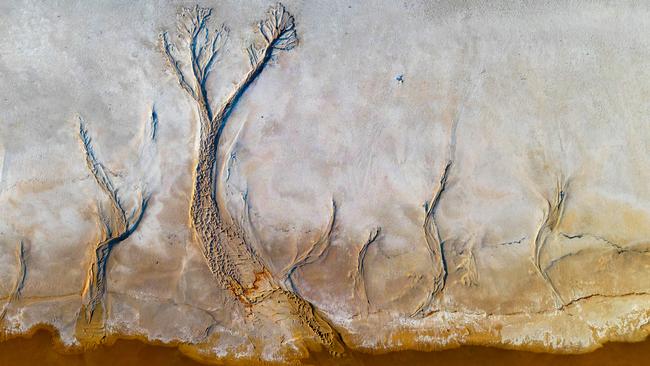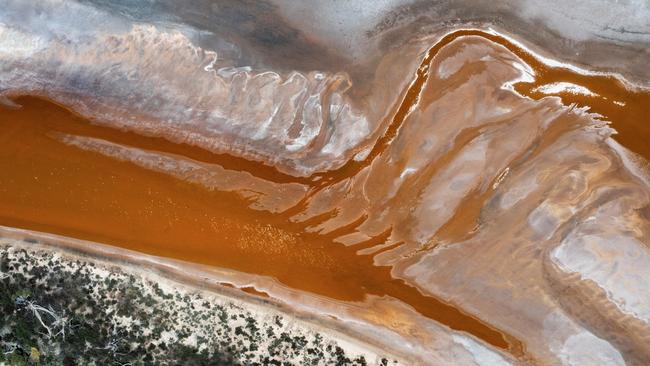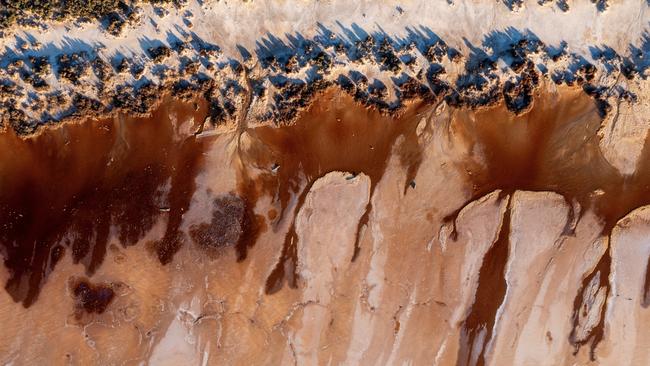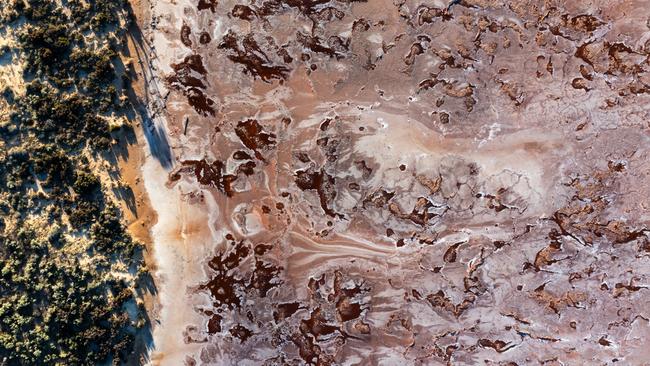Visitors to Lake Tyrrell have transformed the nearby town
Locals feared the Covid pandemic would stop the steady stream of visitors to Lake Tyrrell. Instead it has become an attraction for Australians looking to explore their own backyard.

From the air it looks like a cross-section from a slab of marble warped by time and weather.
On closer inspection, the tree-like tendrils fanning out across the speckled, white crust of Lake Tyrrell reveal themselves as eroding channels of salt, sand and clay.
Rust- and toffee-coloured veins stretch from the shrub-lined shore into the lake’s salty, snowlike crust in psychedelic swirls.
It’s a vast splatter of pink, brown, white and grey that disrupts the ordered tartan pattern of cropping and sheep farms of Victoria’s northwestern Mallee region.
The vibrant colours don’t end at the shoreline.
Otherwise bare walls in the main street of nearby Sea Lake are splashed with bright murals, and even the giant grain silos on the southern entrance to the town are covered in the same splendid palette.
The colours and patterns on the salt lake and the silos and the murals are behind the remarkable turnaround in the fortunes of Sea Lake, 75km west of Swan Hill.
A decade ago, the only remaining pub in town was on its last legs, and jobs, aside from seasonal agricultural work, were scarce.
Now, Sea Lake has four cafes, an art gallery, a busy pub, two motels, a visitor information centre and a selection of short-term housing for visitors.
“There’s no way a town of 600 could support all that,” says retired teacher turned gallery, cafe and accommodation owner Jacqui Mott.
“It’s definitely the tourists feeding that.”

Sea Lake’s change in fortune started in 2016 with the sharing on social media in China of pictures of the pink-hued lake.
Suddenly, Chinese tourists were walking the dusty streets of Sea Lake on their way to see the spectacle.
Savvy locals realised the potential to diversify the economy of the agricultural district.
Some thought the tourism boom would be a flash in the pan but, almost 10 years since the eye-catching photos first hit Chinese social media, the tourism tide has not abated.
It has changed in that time, with domestic tourists now making up a significant portion of the visitors, particularly since the Covid pandemic and Victoria’s strict lockdowns shut down access to the outside world.
But still they come at all times of the year to take in the glorious sight.
“Agriculture is still the most important industry and always will be, but tourism has helped revise the facade of the town,” says Ms Mott’s husband, Rohan, a farmer whose penchant for photography developed as the lake’s allure grew.
“People are coming back to the town looking for work. Prior to that they were coming to the town to escape work. It’s turned around and is really positive.”
In 2018, the Motts transformed an old bank into a basic gallery to display photos of the lake.
“It started just as the gallery and then we thought people would stay longer if they had a coffee to drink while they browsed,” Ms Mott says.
“Then we decided they might need some accommodation, and people started asking for food as well.

“If you look at the town now compared to 10 years ago it is an unbelievable transformation.”
As word spread, the lake became an attraction for photographers whose images in turn generated more interest.
At night, the lack of light pollution and the open horizon make the 20,860ha lake bed the perfect viewing platform for the stars.
And under the right conditions, a thin, still film of water on its surface flawlessly mirrors the sky above.
“Early on it was mostly the mirror-image that the photographers focused on,” Ms Mott says.
“But since then, the drones have really taken off.
“It’s the colour, the way the lake changes, and the different patterns in the salt.
“It’s just stunning.”
The ever-changing nature of the lake’s sunbaked surface mean no two visits are the same.
In summer, when the lake is mostly dry, tourists and photographers still find a reason to endure the Mallee’s crisp heat.
“Even in summer it is spectacular. It looks like a moonscape,” Ms Mott says.

“It’s the vastness, the sense of space and the desolation.”
The ancient lake was an attraction long before the farmers and tourists arrived, with a variety of artefacts providing evidence of thousands of years of Indigenous habitation.
On its northwestern edge, a commercial salt works extracts about 100,000 tonnes of salt a year in a self-replicating process that has been occurring since 1896.
For 47 years, Lake Tyrrell was also the base of the Mallee Rally, which was shut down in 2019 over concerns it would harm Indigenous heritage sites, although there is a push for it to return in some form.
Mr Mott, who grew up on a property next to the lake, admits he had never previously appreciated its beauty as he farmed alongside it.
“I didn’t think much of it,” he says.
“I saw it, from an agricultural perspective, as a wasteland.”
But he joined the bandwagon in 2016 and the lake has become integral to his life.
“It’s hard to take a bad photo of the lake,” Mr Mott says.
“It changes so much. It’s always different. That’s part of the appeal. There's so much to see there.
“It’s ever-changing and you do get some amazing reflections, colours and patterns.”






To join the conversation, please log in. Don't have an account? Register
Join the conversation, you are commenting as Logout